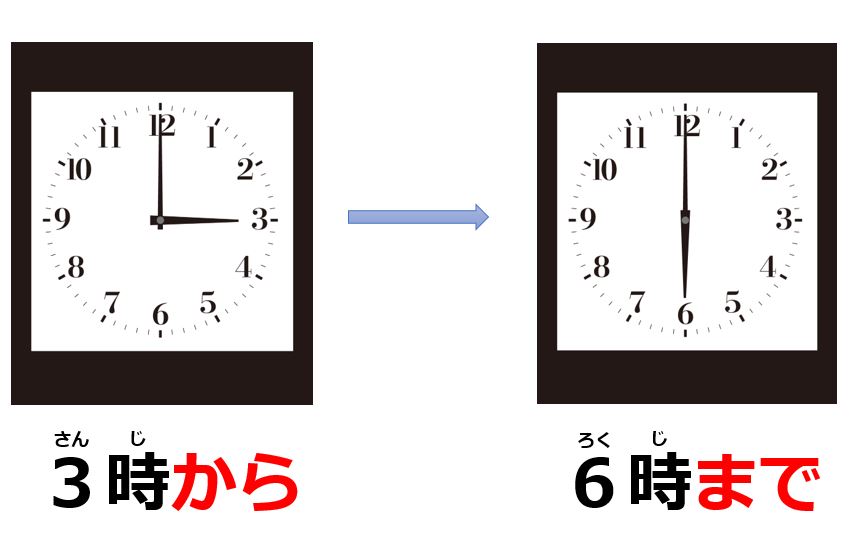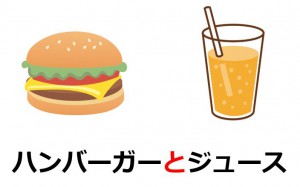Last time, you learned what function the particle で has and how to use them. The better you understand Japanese particles, the variety in your expressions can increase. Here, you will learn the particles から and まで.
Explanation for How the Particles から and まで Work
Since まで is often used together with から, you will come to understand the usage by learning the particle から. Let’s go over them one by one.
Four Functions of the Particle から
Starting Point: から and Ending Point: まで
| [私は / が] | 家から | 駅まで | 歩く / 歩きます |
| [Topic / Subject] | Starting Point | Ending Point | Verb |
| [I will] walk from my house to the station. | |||
The first function is that から expresses starting points and まで expresses ending points. This usage is applicable not only for locations, but also time, and order as well. Here are more examples.
| 朝から夜まで(働く / 働きます)。 [I will] work from morning to night. |
| 朝5時から夜9時まで(寝る / 寝ます)。 [I will] sleep from 5:00am to 9:00pm. |
| 1番から3番まで(歌う / 歌います)。 [I will] sing from the first verse to the third verse. |
The particles から and まで don’t always have to be used together.
| 今から(起きる / 起きます)。 [I will] get up now. |
| 学校は家から遠い(です)。 The school is far from my house. |
| 昼まで(寝る / 寝ます)。 [I will] sleep until daytime. |
| 駅まで(走る / 走ります)。 [I will] run up to the station. |
Advanced Topic: から (Starting Point) VS. を (Location to Leave)
| 東京 を・から 出発(する / します)。 [I will] depart from Tokyo. |
| 仕事 を・ [I will] quit my job. |
| 煙が窓 Smoke will go out from the window. |
When you express actual places to leave, you can use either the particle を or から (Ex 1). However, you cannot use から when you express organizations to leave (Ex. 2) and you cannot use を when subjects are inanimate (Ex. 3).
Advanced Topic: まで (Ending Point) VS. に or へ (Destination)
| 駅 に・へ・まで 行く。 |
When you use motion verbs like “行く: to go,” “来る: to come,” and “着く: to arrive,” you can use any of に, へ, and まで. Please keep in mind that に and へ imply that places you mention are the final destination while まで implies part of the destination. Therefore, with the example above, if you meet up with someone at the station, に and へ are more suitable. If you take a train and go to somewhere else, まで is more suitable.
| 南極 に・へ・ [I will] go to the South Pole. |
With this example, the South Pole can hardly be part of the destination, so に and へ are more suitable.
| 駅 |
One important usage here is that when you use action verbs like “歩く: to walk,” “走る: to run,” and “泳ぐ: to swim,” you have to use まで.
[adsense]
Source
| [私は / が] | お母さんから | 話を | 聞く / 聞きます |
| [Topic / Subject] | Source | Direct Object | Verb |
| [I will] hear the story from my mother. | |||
The second function is to express sources. In this context, から is interchangeable with the particle に. Regarding the sentence order, から can be placed anywhere before the verb. Here are more examples.
| 先生 から・に 本を(もらう / もらいます)。 [I will] receive a book from my teacher. |
| お金を友達 から・に (借りる / 借ります)。 [I will] borrow money from my friend. |
Raw Material
| [私は / が] | 米から | 酒を | 作る / 作ります |
| [Topic / Subject] | Raw Material | Direct Object | Verb |
| [I will] make alcohol from rice. | |||
The third function is to express raw materials. You may wonder what the difference is between using the particle で (materials) and から. Just like the difference between “A is made of B” and “A is made from B,” から is more suitable when you cannot visually judge what materials are used to make products.
| ブドウからワインを(作る / 作ります)。 [I will] make wine from grapes. |
| 牛乳からバターを(作る / 作ります)。 [I will] make butter from milk. |
State Before Change
| 信号が | 赤から | 青に | 変わる / 変わります |
| Subject | State Before Change | Target | Verb |
| The traffic lights will change from red to blue. *In Japan, the colors of traffic lights are blue, yellow and red. |
|||
The fourth function is to express states before changes. Targets of changes are expressed by the particle に.
| 学生から先生に(なる / なります)。 [I will] become a teacher from a student. |
| 季節が春から夏に(変わる / 変わります)。 The season will change from spring to summer. |
Summary
- The particle から can express:
- Starting Point (while まで can express Ending Point)
- Source
- Raw Material
- State Before Change
The functions are similar to the word “from” in English. However, they are of course not the same. Please learn Japanese grammar as it is. For the sake of simplicity, we have given examples where the number of subjects or objects is kept to one. What if there are more than one? We will learn parallel markers next.





